Western landscape has a long and storied history in American culture. In the 19th century, artists who painted outdoor scenes, particularly in the American West, communicated a feeling of what can only be described as reverence for the broad open visas and mountain majesties.
In other words, in the 1800s, landscape painting had religious undertones. Two hundred years later, it appears not much has changed: artists who paint landscapes tend to demonstrate awe in the face of America the Beautiful, an emotion that sadly now resonates with fewer and fewer places, magical outdoor locales that, so far anyway, remain uncorrupted by industry and development in general, pollution and climate change.
Such is the case with the four differently, but equally talented artists in a show at the Slate Gray Gallery North titled by curator/gallery director Krissy Kula Sheer Imagination. (Pun intended.)
On display through June, the exhibition features the work of Cie Hoover, Gina Sarro, Kathryn Tatum, and Joseph Toney, who share the fact they never met a mountain or a sky they did not like. And while their mediums and creative processes are very different, the artists come together in the underlying impulse for their disparate works, collectively a synthesis of close observation, memory, and fantasy inspired by the natural world.
Cie Hoover:
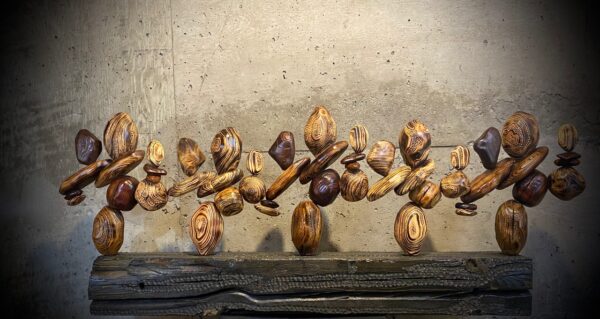
The Balance of All Things, Hoover.
Artist, musician, husband, Cie Hoover lives in Ouray, Colorado, otherwise known as the “Switzerland of America.” In addition to performing alongside his wife Karisa in the folk-rock duo You Knew Me When, Cie has always had a passion for the visual arts. After working in the Nashville music industry for over a decade, then touring full-time for six and a half years throughout North America, credit the San Juan mountains for rekindling Cie’s love for creating original works with his own hands.
After buying and remodeling an old 1898 mining house in Ouray, Cie discovered the versatility of wood as a medium and transformed his garage into a woodworking studio filled with routers, saws, and stains. Cie uses wood in nearly every aspect of the art he creates, from wooden canvases to carved sculptures.
A number of Cie’s pieces also incorporate the use of sound waves both as artistic elements, as well as subtle hints about what a particular work of art is meant to communicate.
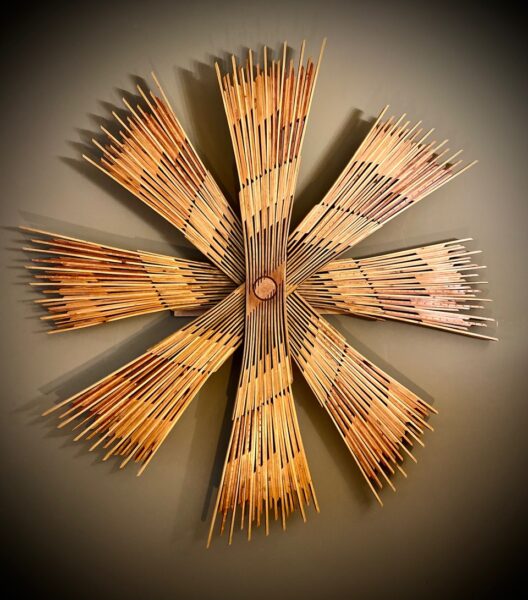
Rays of Light, Hoover.
“My aim with my pieces is to enhance the innate beauty found in wood and to highlight the three predominant themes found in my art: Balance – as showcased through delicate sculptures; Sound – as showcased through wooden sound waves; and Nature – as showcased through various carvings of mountains and landscapes.
“Woodworking is tactical art form,” the artist continues. “I use it as a means to stay connected with the natural elements that surround me. Through nature I find art. Through art I find balance. And, through balance I find peace.”
Gina Sarro:
When Moments Last Forever, Sarro.
Artists like J.M.W. Turner, Winslow Homers and others, including Bruce Gomez, an early player in the stable of the former Telluride Gallery of Fine Art, years ago pulled off the same hat trick Slate Gray artist Gina Sarro manages now.
Gina’s art presents as realism, that is her paintings in her muted palette clearly read as landscapes. But at second glance, the fuzzy outlines of sky, mountains, trees, water, tilt her work towards abstraction. The paintings are, according to the artist, landscapes from the interior. Memory pieces.
“The literal subject of my work is my surroundings. I paint vast, serene landscapes focussing on simplicity and calm while simultaneously searching for how to document shared life moments.,” she explains in her artist statement. “My intention is to offer a landscape sanctuary where realism is intertwined with abstraction offering a reprieve from the overwhelming world events and unknowns we are all experiencing while living during a pandemic. Through a distinct technique, skies, mountains, water, and trees evoke both flatness and depth. I use both a brush and knife partly to diminish, and partly to layer the paint itself while balancing strong compositional horizontals with rhythmic vertical gestures.
“There’s something about the permanence, but also the fragility of the landscape that resonates with me; outdoors are places to breathe and explore, therefore we all need to care for, nurture and be guardians of the landscape so that it is always there for us.”
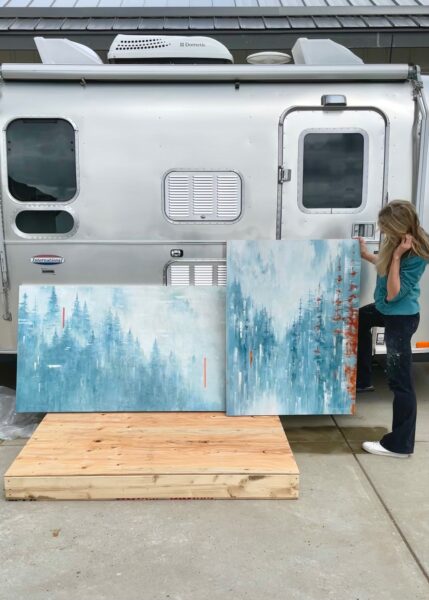
Gina draws inspiration from homes in Saskatchewan, where she was born, and the Alberta foothills, where she completed an economics degree at the University of Calgary and studied painting at Alberta College of Art and Design.
Gina also attended the Emily Carr University of Art and Design in Vancouver, where she currently resides. Her work is held in private and corporate collections in Canada, the US and Australia.
Kathryn Vinson Tatum:
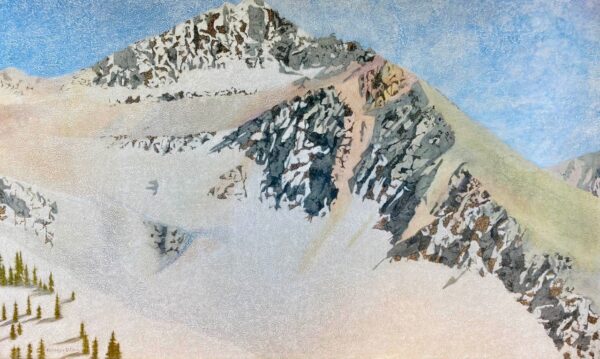
Vermilion Peak, Tatum.
Action painting. Two words that are synonymous with Abstract Expressionism, back when – right after WWII, when the center of the art world shifted to New York from Paris – and now, with AbEx 2.0 painters.
But Kathryn Tatum is not one of them. Instead she is a painter of action. Kathryn captures the mountains of Telluride and Taos, her two homes, in paintings that celebrate the emotional impact of being on top of the world above tree line. In short, “off-piste” describes Tatum both as an artist and as a skier who regularly enjoys shooting the moon.
Kathryn’s journey from graphic designer to rock stars to fine art painter in the Rockies began in rural New Jersey:
“For the first 10 years of my life we lived without neighbors or kids in our community. If my best friend, my brother, and I weren’t up to something adventurous, I was busy drawing and painting in the screened in, year-round, porch my parents made into an art studio for me.”
Years later, a move to Telluride came as a result of Kathryn’s work for Top Notch Resort and Spa, the team that designed the Spa at The Peaks in Mountain Village.
“I applied for and became the restaurant manager for The Peaks Hotel’s Alpine Glo in 1992. Awestruck by the natural beauty of Telluride and the San Juan Mountains, I once again set up my easel and put paint to canvas…”
Humbled by the extreme above-tree-lined landscapes surrounding the Telluride ski area, Kathryn never really knew how to communicate the beauty of these jaw-dropping vistas until recently. Today, her modern mountain images are comprised of geometric patterns, layers of hand-made paint, dry mineral pigments, mica and wax, all to capture the sacred light found on top of peaks. These high-elevation paintings are multidimensional and light reflective. Kathryn refers to them as “postmodern landscapes.”
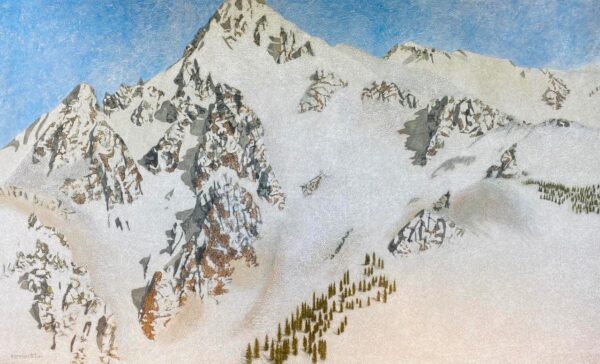
Golden Horn Peak, Tatum.
“There are other hidden treasures I encourage everyone to discover for themselves, the variegated beauty of the mountains I am privileged to call home. The place where my twin passions, painting and skiing, come together,” said the artist.
Kathryn’s work was the inspiration for the poster image for the Telluride Jazz Festival 2003-2005. In addition to Slate Gray, her work is displayed in the Nicolai Fechin Museum in Taos, New Mexico and in the annual Taos Select Fall Arts Show.
Joseph Toney:
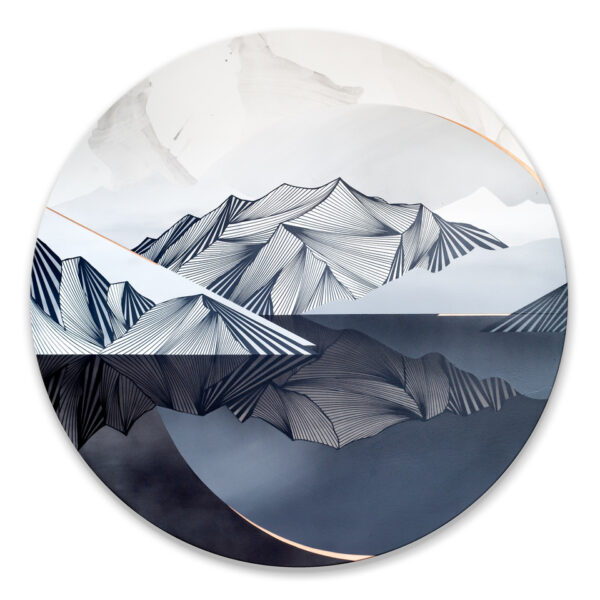
Like Kathryn, mountainous playgrounds also inspire Joseph Toney. In his illustrative abstractions, majestic mountains are reduced to clean lines and muscular patterns. These contour studies summarize the richness and variety of the awesome shapes the artist has loved since his childhood growing up in Appalachia, spitting distance from a ski mountain.
Joseph’s creative process begins when he is out ski touring, biking, or hiking, camera in tow. Photograph in hand, initially he executes his painting with freehand sketches, then finishes the work using a process he sums up as “device drawing,” a technique that involves the use of rulers, French curves, and a makeshift compass. The resulting pieces, executed in acrylic and resin and now charcoal, are directly translated onto wood panels.
The Chinese term for “landscape” is comprised of two characters which translate to “mountains and water.” The age-old tradition is linked with the philosophy of Taoism, which emphasizes harmony between man and the natural world.
Cubist paintings, landscapes or otherwise, broke with the academic convention of a single viewpoint. It is as if the artists kept shifting positions and then attempted to combine the different “views” they saw onto a surface. The resulting image is a complex interlocking and overlapping of forms. The subject is transformed into a kind of geometry – or architecture – often rectilinear in makeup.
East meets West, past meets present, in the edgy, increasingly abstract landscapes of Joseph Toney, who cites both Chinese scroll art and Cubism as key influences.
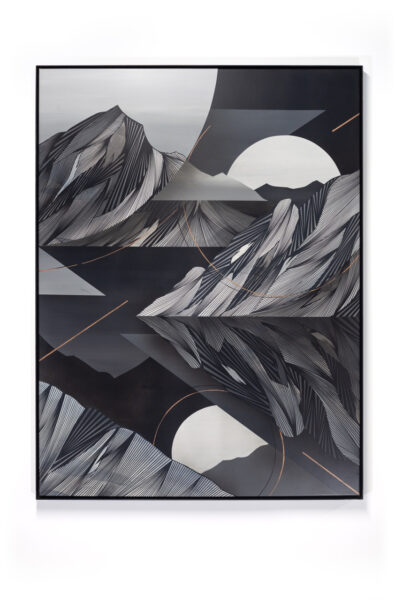
Moonlight, Toney.
The artist Caspar David Friedrich once said “The artist’s feeling is his law.” Joseph’s feeling?: unbridled enthusiasm.
“My goal is for my art to communicate the sense of completeness, liveliness, and excitement I feel when I spend time in the mountains.”
A statement that serves to underline the title of the first group show of the summer season, again, Sheer Imagination.
SUSAN VIEBROCK

